Husqvarna R120S User Manual

Operator’s manual Manuel d’utilisation
Manual de instrucciones
R 120S
Please read the operator’s manual carefully and make sure you understand the instructions before using the machine. Liattentivement et bien assimiler le manuel d’utilisation avant d’utiliser la machine.
Lea detenidamente el manual de instrucciones y asegúrese de entender su contenido antes de utilizar la máquina
English (2-28)
French (29-57)
Spanish (58-85)

CONTENTS
Contents |
|
.......................................................General lubrication |
25 |
|
CONTENTS |
|
Troubleshooting schedule |
|
|
|
Troubleshooting schedule |
25 |
||
Contents |
2 |
|||
Storage |
|
|||
INTRODUCTION |
|
|
||
|
Winter storage |
27 |
||
Dear customer! |
3 |
|||
Service |
27 |
|||
Driving and transport on public roads |
3 |
|||
TECHNICAL DATA |
|
|||
Towing |
3 |
|
||
Original instructions |
27 |
|||
Use |
3 |
|||
|
|
|||
Good service ................................................................ |
3 |
|
|
|
Service journal |
|
|
|
|
Pre-delivery service ..................................................... |
4 |
|
|
|
After the first 8 hours ................................................... |
4 |
|
|
|
KEY TO SYMBOLS |
|
|
|
|
Symbols ....................................................................... |
5 |
|
|
|
SAFETY INSTRUCTIONS |
|
|
|
|
Safety instructions ........................................................ |
8 |
|
|
|
Driving on slopes ......................................................... |
9 |
|
|
|
Children ....................................................................... |
10 |
|
|
|
Maintenance ................................................................ |
10 |
|
|
|
Transport ...................................................................... |
11 |
|
|
|
WHAT IS WHAT? |
|
|
|
|
Location of the controls ................................................ |
12 |
|
|
|
PRESENTATION |
|
|
|
|
Presentation ................................................................. |
13 |
|
|
|
Cutting unit ................................................................... |
13 |
|
|
|
Seat ............................................................................. |
14 |
|
|
|
Fueling ......................................................................... |
14 |
|
|
|
Release lever ............................................................... |
14 |
|
|
|
Driving |
|
|
|
|
Before starting ............................................................. |
15 |
|
|
|
Start the engine ........................................................... |
15 |
|
|
|
Starting the engine with a weak battery ....................... |
16 |
|
|
|
Driving the Rider .......................................................... |
16 |
|
|
|
Cutting tips .................................................................. |
17 |
|
|
|
Stop the engine ............................................................ |
17 |
|
|
|
Maintenance |
|
|
|
|
Maintenance schedule ................................................. |
18 |
|
|
|
Cleaning ....................................................................... |
19 |
|
|
|
Removing of the machine hoods ................................. |
19 |
|
|
|
Checking and adjusting the steering wires .................. |
20 |
|
|
|
Adjusting the brake ...................................................... |
20 |
|
|
|
Adjusting the throttle wire ............................................ |
20 |
|
|
|
Replacing the air filter .................................................. |
21 |
|
|
|
Replacement of fuel filter ............................................. |
21 |
|
|
|
Checking the fuel pump’s air filter ................................ |
21 |
|
|
|
Checking the Tire Pressure .......................................... |
22 |
|
|
|
Ignition system ............................................................. |
22 |
|
|
|
Fuses ........................................................................... |
22 |
|
|
|
Check the safety system .............................................. |
22 |
|
|
|
Checking the engine’s cooling air intake ...................... |
22 |
|
|
|
Service position for the cutting unit .............................. |
23 |
|
|
|
Checking the blades .................................................... |
24 |
|
|
|
Lubrication |
|
|
|
|
Checking the engine’s oil level. .................................... |
25 |
|
|
|
Replacing the engine oil .............................................. |
25 |
|
|
|
Lubricating the front wheel bearings ............................ |
25 |
|
|
|
|
|
|
|
2 – English

INTRODUCTION
Dear customer!
Thank you for choosing a Husqvarna Rider. Husqvarna Riders are built to a unique design with a front-mounted cutting deck and a patented articulated steering. Riders are designed for maximum efficiency even in small or confined areas. The closely grouped controls and pedal-operated hydrostatic transmission also contribute to the performance of this machine.
This operator’s manual is a valuable document. By following its instructions (on operation, service, maintenance, etc.) you will significantly extend the life of the machine and even its second-hand value.
When you sell your Rider, make sure you pass on the operator’s manual to the new owner.
The last chapter in the operator’s manual consists of a Service Journal. Make sure that all service work and repairs are recorded. A well-documented service history reduces the costs of seasonal maintenance and influences the second-hand value of the machine. Bring the operator’s manual with the Rider when bringing it to a workshop for service procedures.
Driving and transport on public roads
Check the relevant road traffic regulations before driving the machine on a public road. If transporting the machine on another vehicle always use approved securing devices and make sure that the machine is securely held.
Towing
When your machine is equipped with a hydrostatic transmission you should only tow the machine over short distances and at a low speed, otherwise there is a risk of damaging the transmission.
The power transmission must be disengaged when towing, see the instructions under the heading Release lever.
Use
This ride-on mower is designed to mow grass on open and level ground surfaces and sloped surfaces that do not exceed 10 degrees. In addition, there is a number of accessories recommended by the manufacturer that broadens the application area. Please contact your dealer for more information about which accessories are available. The machine may only be used with the equipment recommended by the manufacturer. All other types of use should be avoided. Compliance with and strict adherence to the conditions of operation, service and repair as specified by the manufacturer also constitute essential elements of the intended use.
This machine should be operated, serviced and repaired only by persons who are familiar with its particular characteristics and who are acquainted with the relevant safety procedures.
Accident prevention Recommendations, all other generally recognized regulations on safety and occupational medicine, and all road traffic regulations must be observed at all times.
Any arbitrary modifications carried out to this machine may relieve the manufacturer of liability for any resulting damage or injury.
Good service
Husqvarna products are sold all over the world and ensures that you, the customer, get the best support and service. For example, before this machine was delivered it was inspected and adjusted by your dealer. See the certificate in the Service Journal in this manual.
When you need spare parts or advice on service issues, warranty terms, etc., contact:
|
|
|
This Operator’s Manual belongs to machine with |
Motor |
Transmission |
serial number: |
|
|
|
|
|
On the machine's rating plate you will find the following information:
•The machines type designation.
•The manufacturer’s type number.
•The machine’s serial number.
State the type designation and serial number when ordering spare parts.
English – 3
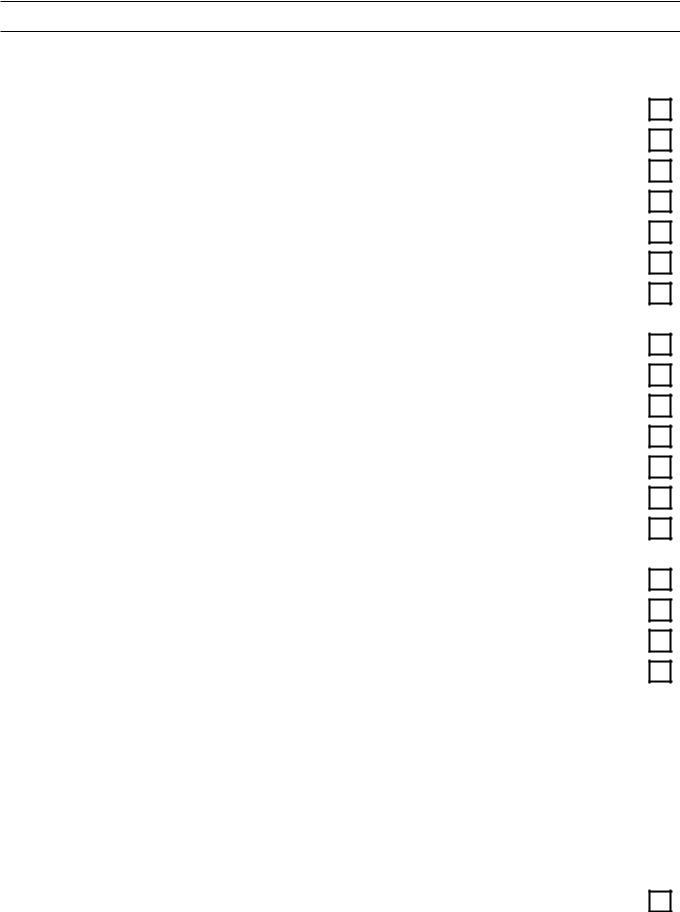
Service journal
Pre-delivery service
1Charge the battery for 4 hours at max. 3 amp.
2Fit steering wheel, seat and any optional equipment.
3Check and adjust tyre pressure. (60 kPa, 0.6 bar, 9 psi).
4Check that the right amount of oil is in the engine.
5Connect battery.
6Fill with fuel and start engine.
7Check that machine does not move in neutral.
8Check: Forward drive.
Reverse drive.
Operation of blades.
Seat safety switch.
Lif lever safety switch.
Safety switch for parking brake.
Check engine speed. See the Technical data section.
9Tell customer about:
Needs and benefits of following the service schedule.
Servicing and the influence of this journal on the second-hand value of the machine.
Range of applications for BioClip.
Complete proof of sale etc.
Pre-delivery service carried out. No outstanding problems. Certified:
_______________________________________________________________________________
Date, mileage, stamp, signature
After the first 8 hours
1 Change engine oil
4 – English
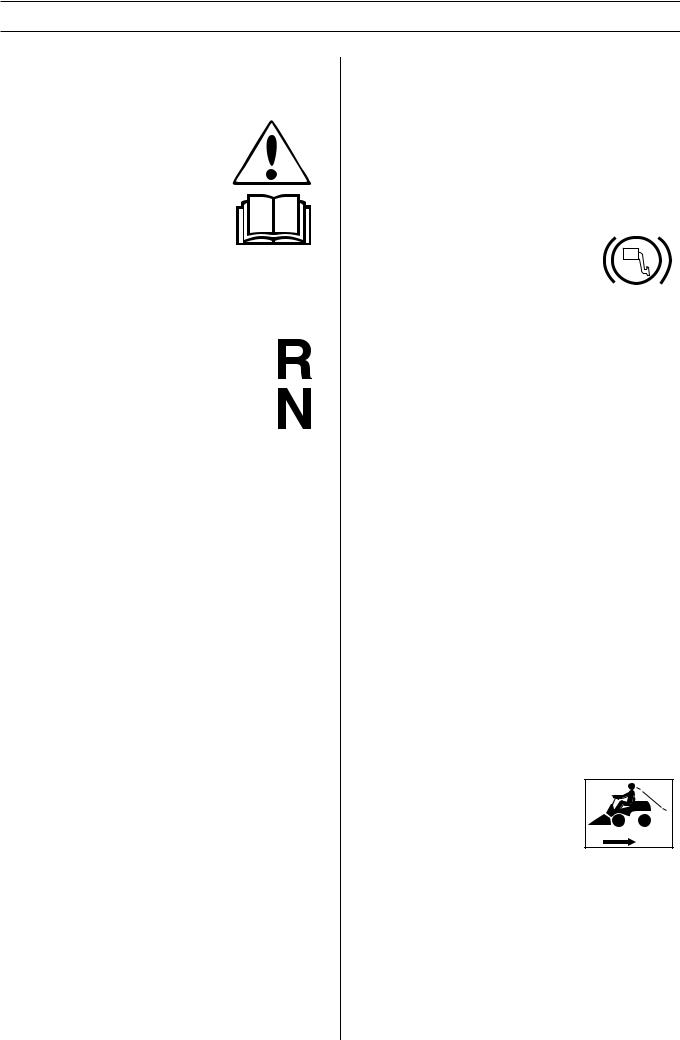
KEY TO SYMBOLS
Symbols
These symbols are on the machine and in the instructions.
WARNING! Careless or incorrect use can result in serious or fatal injury to the operator or others.
Please read the operator’s manual carefully and make sure you understand the instructions before using the machine.
Always wear:
• Approved hearing protection
Reverse
Neutral
Fast
Slow
Stop the engine.
Battery
Choke.
Oil level
Cutting height
Backwards
Forwards
Ignition
Warning: rotating parts. Keep hands and feet clear.
Clutch engaged, blades turning
Clutch disengage, blades not turning
Parking brake
Brake
Clutch
Rotary blades Keep hands and feet away from under the hood when the engine is running
Do not use the Rider on ground that slopes more than 10°.
>10
Never use the machine if persons, especially children, or animals, are in the vicinity
Never carry passengers on the machine or equipment
Drive very slowly if no cutting unit is fitted
Before and during reversing procedures, look behind you.
Switch off the engine and take off the ignition cable before repairs or maintenance
English – 5

AMERICAN STANDARD SAFETY PRECAUTIONS
Safety instructions for ride-on mowers
•
ANSI/OPEI B71.1-2012
IMPORTANT Safe Practices for Ride-on Mowers
This cutting machine is capable of amputating hands and feet and throwing objects. Failure to observe the following safety instructions could result in serious injury or death.
I. GENERAL OPERATION
1.Read, understand, and follow all instructions on the machine and in the manual(s) before starting.
2.Do not put hands or feet near rotating parts or under the machine. Keep clear of the discharge opening at all times.
3.Only allow responsible adults who are familiar with the instructions to operate this machine.
4.Clear the area of objects such as rocks, wire, toys, etc., which could be thrown by the blade(s).
5.Be sure the area is clear of bystanders before operating. Stop machine if anyone enters the area.
6.Never carry passengers.
7.Do not mow in reverse unless absolutely necessary. Always look down and behind before and while backing.
8.Never direct discharged material toward anyone. Avoid discharging material against a wall or obstruction. Material may ricochet back toward the operator. Stop the blade(s) when crossing gravel surfaces.
9.Do not operate machine without the entire grass catcher, discharge guard, or other safety devices in place and working.
10.Slow down before turning.
11.Never leave a running machine unattended. Always turn off blade(s), set parking brake, stop engine and remove key before dismounting.
12.Disengage blade(s) when not mowing. Shut off engine and wait for all parts to come to a complete stop before cleaning the machine, removing the grass catcher, or unclogging the discharge guard.
13.Operate machine only in daylight or good artificial light.
14.Do not operate machine while under the influence of alcohol or drugs.
15.Watch for traffic when operating near or crossing roadways.
16.Use extra care when loading or unloading the machine into a trailer or truck.
17.Always wear eye protection when operating machine.
18.Data indicates operators age 60 years and above are involved in a large percentage of riding mower related injuries. These operators should evaluate their ability to operate the riding mower safely enough to protect themselves and others from serious injury.
19.Follow the manufacturer’s recommendation for wheel weights or counterweights.
II. SLOPE OPERATION
Slopes are a major factor related to loss of control and tip over accidents, which can result in severe injury or death. Operation on all slopes requires extra caution. If you cannot back up the slope or if you feel uneasy on it, do not mow it.
1.Mow up and down slopes, not across.
2.Watch for holes, ruts, bumps, rocks, or other hidden objects. Uneven terrain could overturn the machine. Tall grass can hide obstacles.
3.Choose a low ground speed so you will not have to stop or shift while on a slope.
4.Do not mow on wet grass. Tires may lose traction.
5.Always keep the machine in gear when going down slopes. Do not shift to neutral and coast downhill.
6.Avoid starting, stopping, or turning on a slope. If the tires lose traction, disengage the blade(s) and proceed slowly straight down the slope.
7.Keep all movement on slopes slow and gradual. Do not make sudden changes in speed or direction, which could cause the machine to roll over.
8.Use extra care while operating machine with grass catchers or other attachments; they can affect the stability of the machine. Do not use on steep slopes.
9.Do not try to stabilize the machine by putting your foot on the ground.
10.Do not mow near drop offs, ditches or embankments. The machine could suddenly roll over if a wheel goes over the edge or if the edge caves in.
III. CHILDREN
Tragic accidents can occur if the operator is not alert to the presence of children. Children are often attracted to the machine and the mowing activity. Never assume that children will remain where you last saw them.
1.Keep children out of the mowing area and in the watchful care of a responsible adult other than the operator.
2.Be alert and turn machine off if a child enters the area.
3.Before and while backing, look behind and down for small children.
4.Never carry children, even with the blade(s) shut off. They may fall off and be seriously injured or interfere with safe machine operation. Children who have been given rides in the past may suddenly appear in the mowing area for another ride and be run over or backed over by the machine.
5.Never allow children to operate the machine.
6.Use extreme care when approaching blind corners, shrubs, trees, or other objects that may block your view of a child.
6 – English

AMERICAN STANDARD SAFETY PRECAUTIONS
IV. TOWING
•
1.Tow only with a machine that has a hitch designed for towing. Do not attach towed equipment except at the hitch point.
2.Follow the manufacturer’s recommendation for weight limits for towed equipment and towing on slopes.
3.Never allow children or others in or on towed equipment.
4.On slopes, the weight of the towed equipment may cause loss of traction and loss of control.
5.Travel slowly and allow extra distance to stop.
V. SERVICE
SAFE HANDLING OF GASOLINE:
To avoid personal injury or property damage, use extreme care in handling gasoline. Gasoline is extremely flammable and the vapors are explosive.
1.Extinguish all cigarettes, cigars, pipes, and other sources of ignition.
2.Use only an approved gasoline container.
3.Never remove gas cap or add fuel with the engine running.
4.Allow engine to cool before refueling.
5.Never fuel the machine indoors.
6.Never store the machine or fuel container where there is an open flame, spark, or pilot light such as on a water heater or other appliances.
7.Never fill containers inside a vehicle or on a truck or trailer bed with a plastic liner. Always place containers on the ground away from your vehicle before filling.
8.Remove gas powered equipment from the truck or trailer and refuel it on the ground. If this is not possible, then refuel such equipment with a portable container, rather than from a gasoline dispenser nozzle.
9.Keep the nozzle in contact with the rim of the fuel tank or container opening at all times until the fueling is complete. Do not use a nozzle lock open device.
10.If fuel is spilled on clothing, change clothing immediately.
11.Never overfill fuel tank. Replace gas cap and tighten securely.
GENERAL SERVICE:
1.Never operate machine in a closed area.
2.Keep all nuts and bolts tight to be sure the equipment is in safe working condition.
3.Never interfere with the intended function of a safety device or reduce the protection provided by a safety device. Check their proper operation regularly
4.Keep machine free of grass, leaves, or other debris build up. Clean up oil or fuel spillage and remove any fuel soaked debris. Allow machine to cool before storing.
5.If you strike a foreign object, stop and inspect the machine. Repair, if necessary, before restarting.
6.Never make any adjustments or repairs with the engine running.
7.Check grass catcher components and the discharge guard frequently and replace with manufacturer’s recommended parts, when necessary.
8.Mower blades are sharp. Wrap the blade or wear gloves, and use extra caution when servicing them.
9.Check brake operation frequently. Adjust and service as required.
10.Maintain or replace safety and instruction labels, as necessary.
English – 7
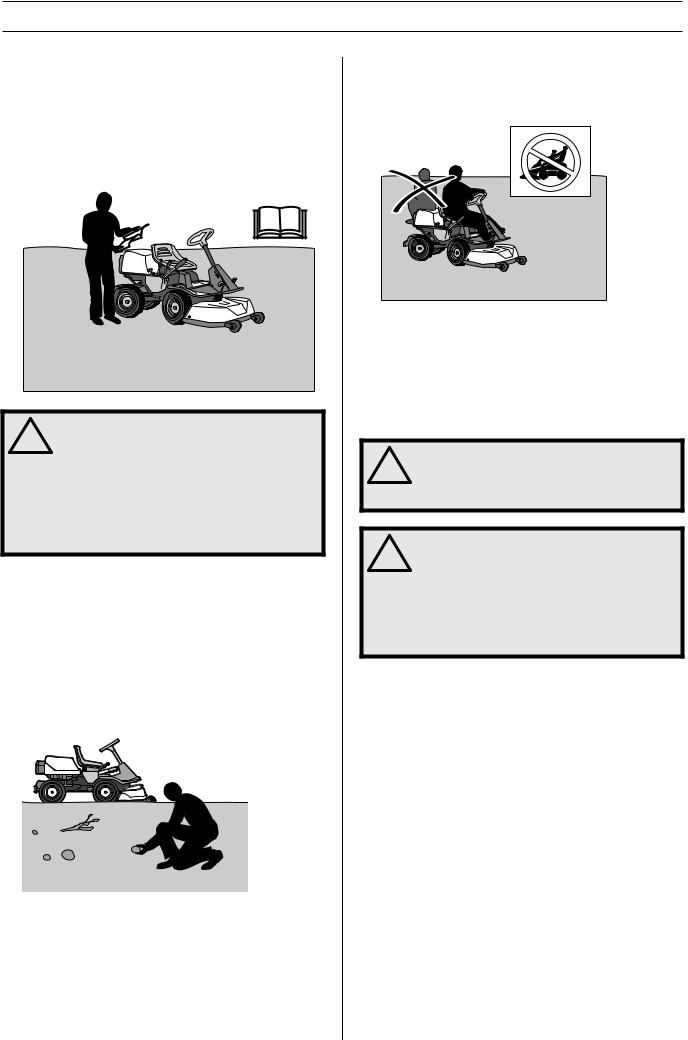
SAFETY INSTRUCTIONS
Safety instructions
These instructions are for your safety. Read them carefully.
General use
•Read all the instructions in this operator’s manual and on the machine before you start it. Ensure you understand them and then observe them.
WARNING! This machine produces an
!electromagnetic field during operation. This field may under some circumstances interfere with active or passive medical implants. To reduce the risk of serious or fatal injury, we recommend persons with medical implants consult their physician and the medical implant manufacturer before operating this machine.
•Learn how to use the machine and its controls safely and learn to how to stop quickly. Also learn to recognize the safety decals.
•Only allow the machine to be used by adults who are familiar with its use.
•Make sure nobody else is in the vicinity of the machine when you start the engine, engage the drive or drive off.
•Clear the area of objects such as stones, toys, wires, etc. that may become caught in the blades and be thrown out.
•Stop the engine, remove the key to prevent the engine from being started until you have cleaned the discharge opening.
•Look out for the mower discharge and do not direct it towards anyone.
•Stop the engine and remove key to prevent it from starting before you clean the cutting unit.
•Remember that the driver is responsible for dangers or accidents.
•Never carry passengers. The machine is only intended to be used by one person.
•Always look downwards and backwards before and while reversing. Keep watch for both large and small obstacles.
•Slow before cornering.
•Switch off the blades when you are not mowing.
•Take care when rounding a fixed object, so that the blades do not hit it. Never run the machine over foreign objects.
! |
WARNING! This machine can sever hands |
and feet as well as throw objects. Failure to |
|
observe the safety instructions can result in |
|
|
serious injuries. |
! |
WARNING! Engine exhaust, some of its |
constituents and certain vehicle |
|
components contain or emit chemicals |
|
|
considered to cause cancer, birth defects or |
|
other reproductive impairment. The engine |
|
emits carbon monoxide, which is a |
|
colourless, poisonous gas. Do not use the |
|
machine in enclosed spaces. |
•Only use the machine in daylight or in other well-lit conditions. Keep the machine at a safe distance from holes or other irregularities in the ground. Pay attention to other possible risks.
•Never use the machine if you are tired, if you have consumed alcohol, or if you are taking other drugs or medication that can affect your vision, judgement or coordination.
•Keep an eye on the traffic when working close to a road or when crossing it.
•Never leave the machine unsupervised with the engine running. Always stop the blades, apply the parking brake, stop the engine and remove the key before leaving the machine.
8 – English
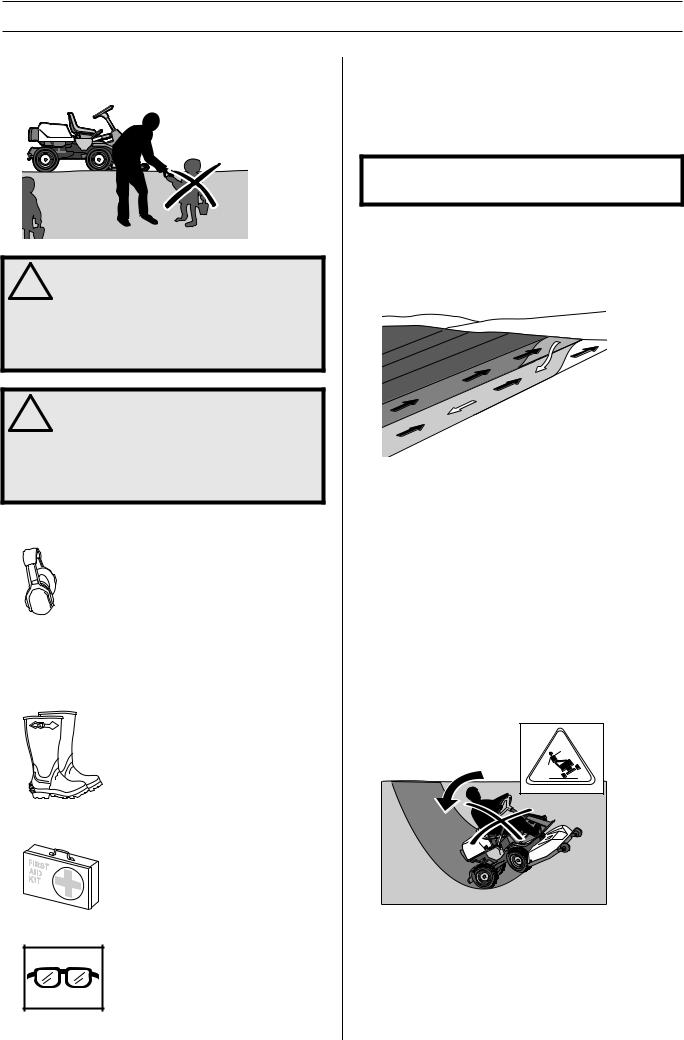
SAFETY INSTRUCTIONS
•Never allow children or other persons not trained in the use of the machine to use or service it. Local laws may regulate the age of the user.
WARNING! CHILDREN CAN BE INJURED BY
!THIS EQUIPMENT. The American Academy of Pediatrics recommends that children be a minimum of 12 year of age before operating a pedestrian controlled lawn mower and a minimum of 16 years of age before operating a riding lawn mower.
WARNING! You must use approved personal
!protective equipment whenever you use the machine. Personal protective equipment cannot eliminate the risk of injury but it will reduce the degree of injury if an accident does happen. Ask your dealer for help in choosing the right equipment.
•Use hearing protection to minimise the risk of hearing impairment.
•Never wear loose-fitting clothing, jewellery or similar that can get caught in moving parts.
•Never use the machine when barefoot. Always wear protective shoes or protective boots, preferably with steel toes.
•Make sure that you have first aid equipment close at hand when using the machine.
•Always wear eye protection when operating machine .
Driving on slopes
Driving on slopes is one of the operations where the risk of the driver losing control of the machine or of it overturning is the greatest; this can result in serious injury or death. All slopes demand extra care. If you cannot reverse up a slope or if you feel unsure, do not mow it.
IMPORTANT INFORMATION
Do not drive down slopes with the cutting deck raised.
This is what you do
•Remove obstacles such as stones, branches, etc.
•Mow upwards and downwards, not sideways.
>10
•Do not use the machine on ground that slopes more than 10°.
•Take extra care if any attachments are fitted that can change the stability of the machine.
•Avoid starting or stopping on a slope. If the tires start to slip, stop the blades and drive slowly down the slope.
•Always drive smoothly and slowly on slopes.
•Do not make any sudden changes in speed or direction.
•Avoid unnecessary turns on slopes, if necessary, turn slowly and gradually downwards if possible. Drive slowly. Do not turn the wheel sharply.
•Watch out for and avoid driving over furrows, holes and bumps. It is easier for the machine to overturn on uneven ground. Tall grass can hide obstacles.
•Do not mow too close to edges, ditches or banks. The machine can suddenly overturn if one wheel comes over the edge of a steep slope or a ditch, or if an edge gives way.
•Do not mow wet grass. It is slippery, and tires can lose their grip so that the machine skids.
English – 9
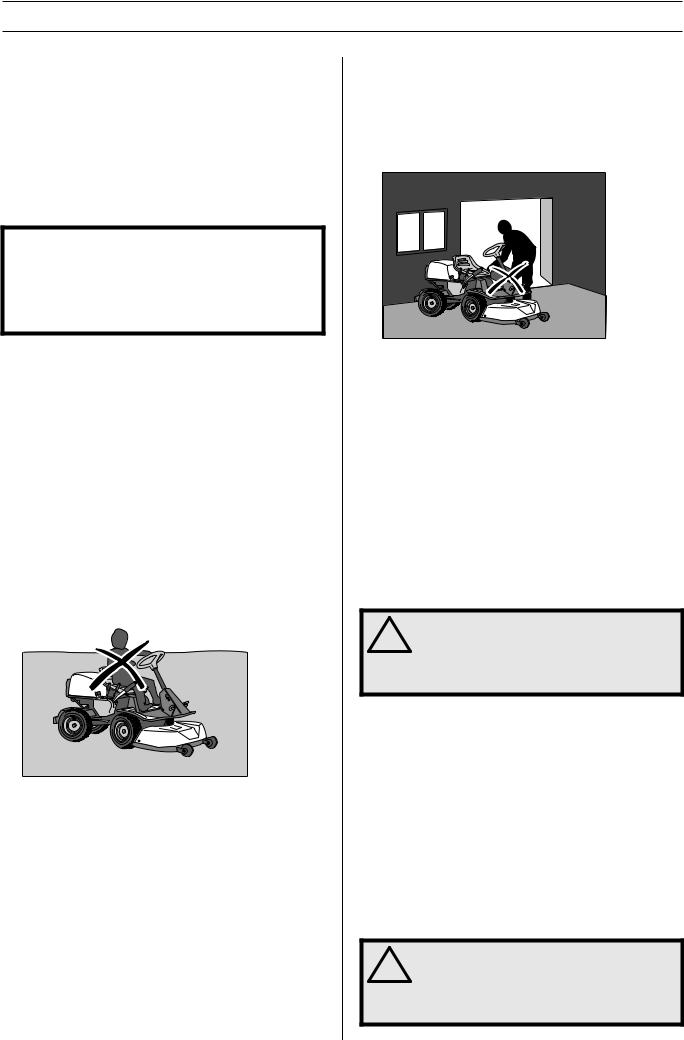
SAFETY INSTRUCTIONS
•Do not try to stabilize the machine by putting your foot on the ground.
•When cleaning the chassis, the machine may never be driven near verges or ditches.
•When mowing, keep away from bushes and other materials in order to avoid a heating effect.
•Follow the manufacturer’s recommendations regarding wheel weights or counterbalance weights to increase machine stability.
IMPORTANT INFORMATION
Wheel weights fitted on the rear wheels are recommended when driving on slopes for safer steering and improved manoeuvrability. Consult your dealer concerning the use of wheel weights if you are unsure. Wheel weights can not be used on AWD-machines. Use counterweights.
Children
•Serious accidents may occur if you fail to be on your guard for children in the vicinity of the machine. Children are often attracted to the machine and mowing. Never assume that children will remain where you last saw them.
•Keep children away from the area to be mowed and under close supervision by another adult.
•Keep an eye out and shut off the machine if children enter the work area.
•Before and during reversing procedures, look behind you and down for small children.
•Never allow children to ride along. They can fall off and seriously injure themselves or be in the way for safe Maneuvering of the machine.
•Never allow children to operate the machine.
•Be particularly careful near corners, bushes, trees or other objects that block your view.
Maintenance
•Stop the engine. Prevent starting by removing the ignition cable from the spark plug or remove the ignition key before making any adjustments or carrying out maintenance.
•Never fill the fuel tank indoors.
•Petrol and petrol fumes are poisonous and extremely flammable. Be especially careful when handling petrol, as carelessness can result in personal injury or fire.
•Only store fuel in containers approved for the purpose.
•Never remove the fuel cap and fill the fuel tank when the engine is running.
•Allow the engine to cool before refueling. Do not smoke. Do not fill petrol in the vicinity of sparks or open flames.
•Handle oil, oil filters, fuel and the battery carefully with environmental considerations. Follow the local recycling requirements.
•Electrical shocks can cause injuries. Do not touch cables when the engine is running. Do not test the ignition system with your fingers.
! |
WARNING! The engine and the exhaust |
system become very hot during operation. |
|
Risk of burn injuries if touched. When |
|
|
mowing, keep away from bushes and other |
|
materials in order to avoid a heating effect. |
•If leaks arise in the fuel system, the engine must not be started until the problem has been resolved.
•Store the machine and fuel in such a way that there is no risk that leaking fuel or fumes can cause any damage.
•Check the fuel level before each use and leave space for the fuel to expand, because the heat from the engine and the sun may otherwise cause the fuel to expand and overflow.
•Avoid overfilling. If you spill petrol on the machine, wipe up the spill and wait until it has evaporated before starting the engine. If you spill on your clothing, change your clothing.
•Allow the machine to cool before performing any actions in the engine compartment.
! |
WARNING! The battery contains lead and |
lead pollutants, chemicals that are |
|
considered to cause cancer, birth defects or |
|
|
other reproductive impairment. Wash your |
|
hands after touching the battery. |
10 – English
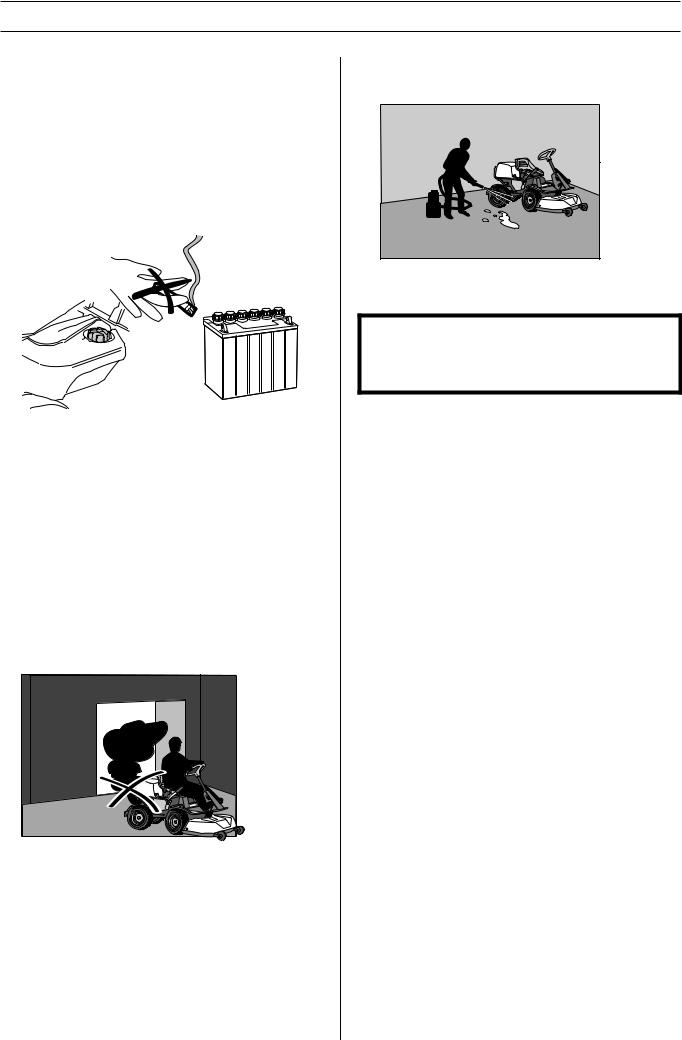
SAFETY INSTRUCTIONS
•Be especially careful when handling battery acid. Acid on the skin can cause serious corrosive injuries. In the event of spillage on the skin wash immediately with water.
•Acid in the eyes can cause blindness. Rinse immediately with plenty of water for at least 20 minutes and contact a doctor immediately.
•Take care with battery maintenance. Explosive gases form in the battery. Never perform maintenance on the battery while smoking or in the vicinity of open flames or sparks. This can cause the battery to explode and cause serious injuries.
•Make sure all nuts and bolts are tightened correctly and that the equipment is in good condition.
•Do not modify safety equipment. Check regularly to be sure it works properly. The machine must not be driven if protective plates, protective covers, safety switches or other protective devices are not fitted or are defective.
•Observe the risk of injury caused by moving or hot parts if the engine is started with the engine cover open or protective cowlings removed.
•Do not change the setting of governors. If you run too fast, you risk damaging the machine components.
•Never use the machine indoors or in spaces lacking proper ventilation. Exhaust fumes contain carbon monoxide, an odorless, poisonous and highly dangerous gas.
•Stop and inspect the equipment if you run over or into anything. If necessary, make repairs before starting.
•Never make adjustments with the engine running.
•The machine is tested and approved only with the equipment originally provided or recommended by the manufacturer.
•The blades are sharp and can cause cuts. Wrap the blades or wear protective gloves when handling them.
•Check regularly that the parking brake works. Adjust and maintain as required.
•Reduce the risk of fire by removing grass, leaves and other debris that may have fastened on the machine. Allow the machine to cool before putting it in storage.
Transport |
IMPORTANT INFORMATION
The parking brake is not sufficient to lock the machine during transport. Ensure you secure the machine firmly to the transporting vehicle.
•The machine is heavy and can cause serious crush injuries. Take extra care when loading it onto or off a vehicle or trailer.
•Use a trailer appropriate for this machine for transporting the machine. Activate the parking brake, and secure the machine using approved fasteners, such as tension belts, chains or ropes when transporting.
•Check and observe local road traffic regulations before transporting or driving the machine on roads.
English – 11

WHAT IS WHAT?
|
6 |
|
|
|
|
|
|
|
7 |
|
|
5 |
4 |
3 |
2 |
|
1 |
8 |
|
|
|
|
|
|
|
|
|
|
|
|
|
13 |
14 |
15 |
16 |
9 |
10 |
11 |
12 |
|
|
|
|
|
Location of the controls
1 |
Lever to disengage the drive |
9 |
Cutting height adjustment lever |
2 |
Battery |
10 |
Water connector |
3 |
Throttle control/choke control |
11 |
Parking brake |
4 |
Ignition lock |
12 |
Lock button for parking brake |
5 |
Lifting lever for the cutting unit |
13 |
Seat adjustment. |
6 |
Side ejection |
14 |
Product and serial number plate |
7 |
Speed limiter for reversing |
15 |
Fuel cap |
8 |
Speed limiter for driving forward |
16 |
Cover lock |
12 – English
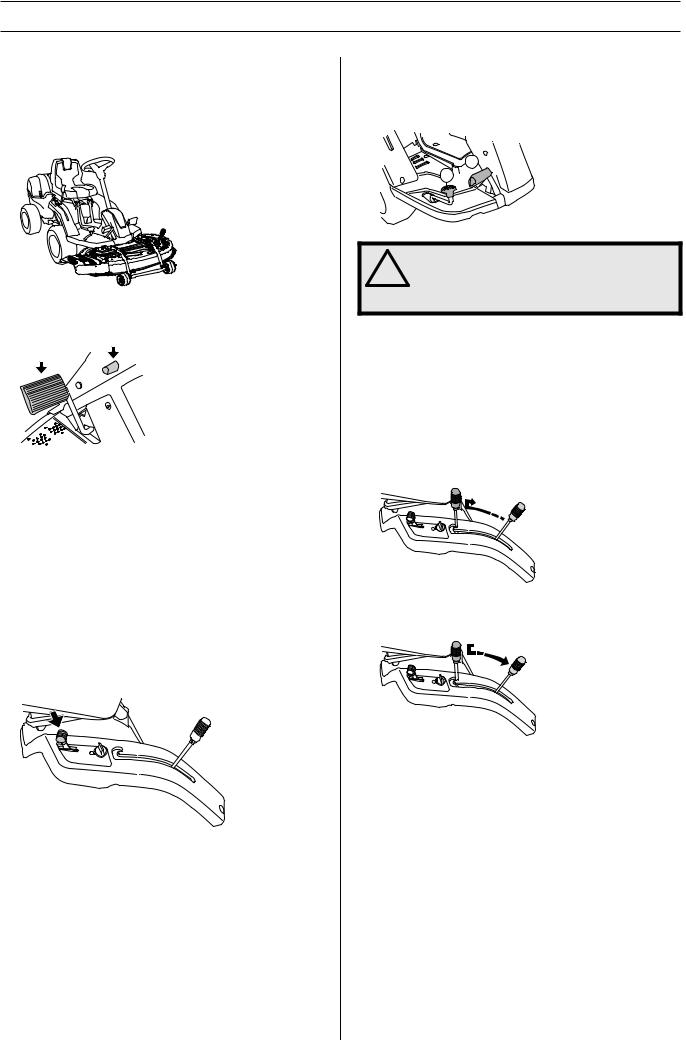
PRESENTATION
Presentation
Congratulations on your choice of an excellent quality product that will give you great pleasure for many years.
Power transmission is provided by a hydrostatic gearbox which allows variation of the speed.
Parking brake
The parking brake is applied as follows:
1Press down the parking brake pedal.
2Press in the lock button on the steering column.
3Release the parking brake pedal while keeping the button pressed in.
The parking brake lock disengages automatically when the brake pedal is pressed.
Throttle and choke controls
The throttle control regulates the engine speed, and thereby also the rotation speed of the blades.
The control is also used to activate the choke. When the choke is engaged a richer fuel and air mixture is fed to the engine, which facilitates starting in the cold.
Drive Controls
This is a variable speed machine. The ground speed is regulated with two pedals. Pedal (1) is used to drive forwards, and pedal (2) to drive backwards.
1 
2 




! |
WARNING! Make sure that branches do not |
obstruct the pedals when mowing under |
|
bushes. Otherwise there is a risk you may |
|
|
lose control. |
Cutting unit
The mower has a 2-blade cutting deck with side ejection.
Lifting lever for the cutting unit
The lift lever is used to set the cutting unit in transport or mowing position.
If the lever is pulled backwards the unit is raised and the blades automatically stop rotating (transport position).
If the lever is moved forwards, the cutting deck will be lowered and the blades will automatically start to rotate (mowing position).
The lever can also be used to temporarily regulate the cutting height, e.g. for a small mound in the lawn.
English – 13
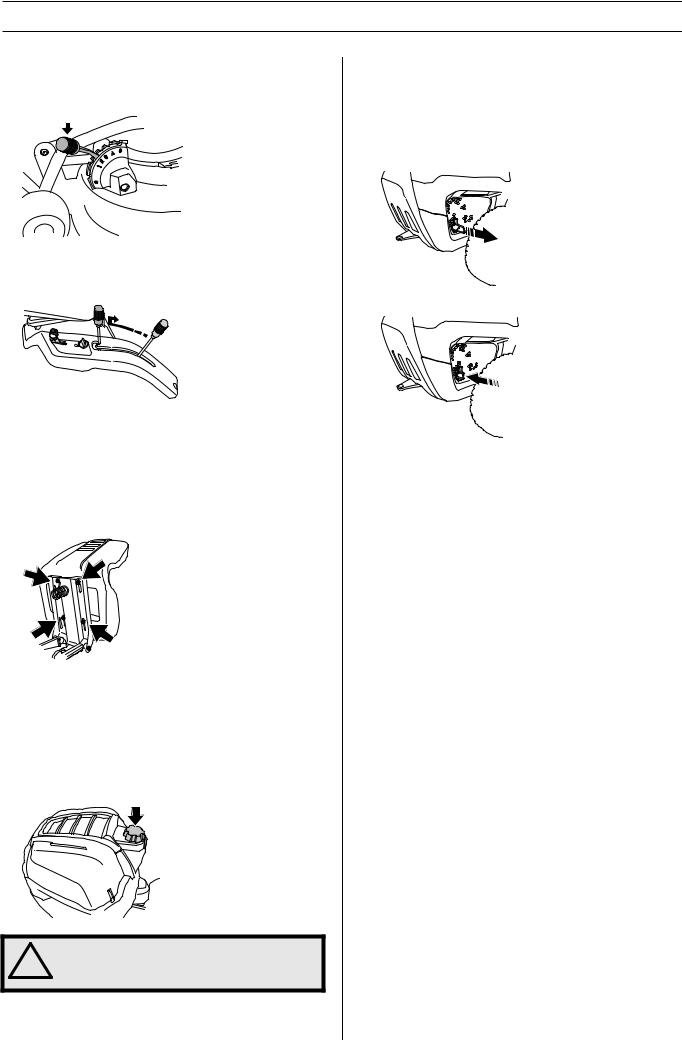
PRESENTATION
Cutting height adjustment lever
The cutting height can be adjusted to 5 (1-5) different positions with the cutting height lever.
Never use position S when mowing. This position is for mower deck servicing only.
Lift up the cutting unit before adjusting the height.
Seat
The seat has a jointed attachment on the front edge and can be tipped forward.
The seat can also be adjusted lengthways.
Loosen the bolts under the seat and adjust it forwards or backwards to the desired position.
Fueling
The engine runs on unleaded petrol with a minimum octane rating of 85 (not mixed with oil). We recommend the use of biodegradable alkylate petrol. Do not use petrol that contains methanol.
Do not fill the tank completely, leave an expansion area of at least 2.5 cm (1“).
WARNING! Petrol is highly inflammable.
!Exercise care and refuel outdoors (see safety instructions).
Release lever
The release control must be pulled out in order for the machine to be moved when the engine is shutoff. Pull the controls to the end positions, do not use an intermediate position.
•Pull out the control to disengage the drive system.
•Push in the control to engage to the drive system.
14 – English
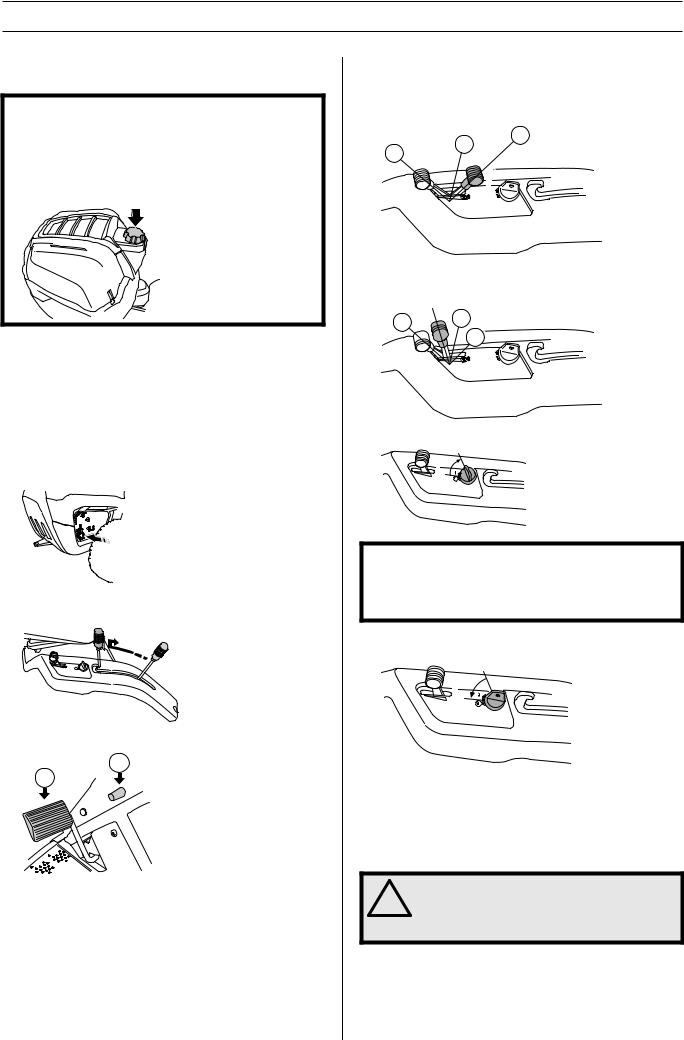
Driving
Before starting
IMPORTANT!
The air intake grille in the engine cover behind the driver’s seat must not be blocked by, for example, clothing, leaves, grass or dirt.
Impaired cooling of the engine. Risk of major engine damage.
•Read the safety instructions and information concerning the placement of controls and functions before starting.
•Perform daily maintenance before starting as set out in the Maintenance schedule.
•Adjust the seat to the required position.
Start the engine
1 Make sure the release lever is pushed in. (Run position)
2Lift up the cutting unit by pulling the lever backwards to its locked position.
3 Activate the parking brake. This is done as follows:
2
1
-Press down the parking brake pedal (1).
-Press in the lock button (2) on the steering column.
-Release the brake pedal while holding the button pressed.
The parking brake lock disengages automatically when the brake pedal is pressed.
With a cold engine:
4Move the throttle to position 3 (choke position). In this position the engine is fed with a richer mixture, which means the engine is easier to start.
3
2
1
With a warm engine:
5 Move the throttle in between positions 1 and 2.
1  2
2

 3
3
6 Turn the ignition key to the start position.
IMPORTANT INFORMATION
If the engine does not start, wait about 15 seconds before trying again. If the engine does not start wait about 1 minute before trying again.
7When the engine starts release the ignition key immediately back to neutral position.
8Push the throttle lever gradually rearward when the engine has started. Let the engine run at moderate speed or half throttle for 3-5 minutes before subjecting it to heavy load.
9Set the required engine speed with the throttle control.
! |
WARNING! Never run the engine indoors, in |
enclosed or poorly ventilated areas. The |
|
exhaust fumes contain toxic carbon |
|
|
monoxide. |
English – 15
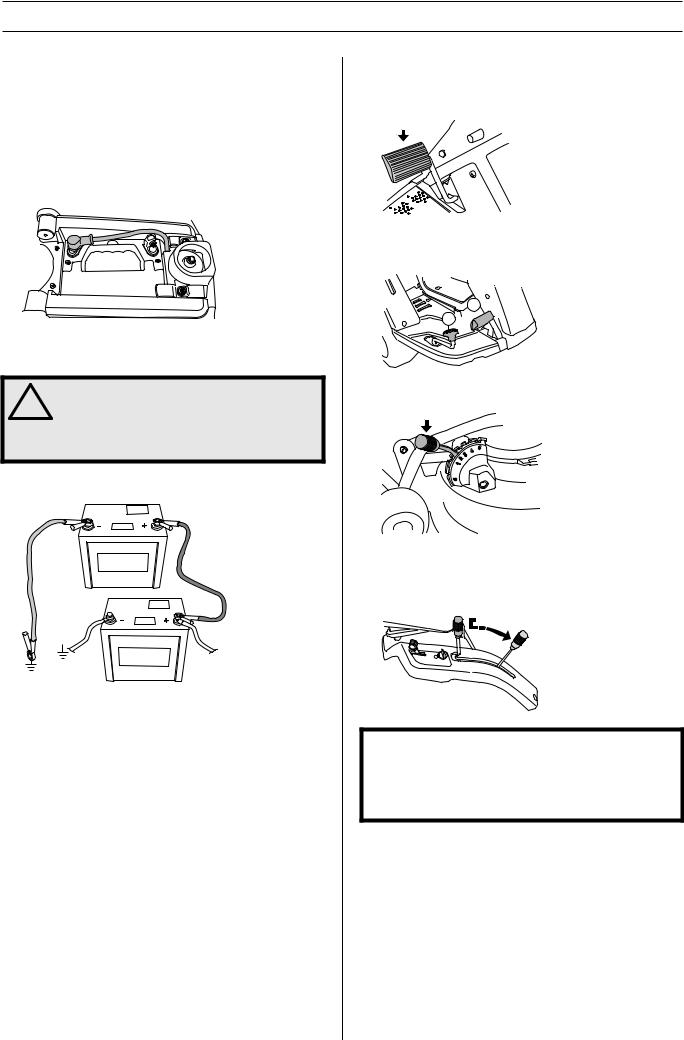
Driving
Starting the engine with a weak battery
If the battery is too weak to start the engine, it should be recharged. Charge the battery for 4 hours at max. 3 amp.
When the battery is fully charged, connect the red cable to the positive pole (+pole) of the battery and the black cable to the negative pole (-pole). Ensure that the red (+) cable is drawn behind the black (-) cable.
When jump leads are used for emergency starting, follow the procedure below:
IMPORTANT INFORMATION Your Rider is
!equipped with a 12-volt system with negative earth. The other vehicle must also have a 12volt system with negative earth. Do not use your Rider battery to start other vehicles.
Connecting the jump leads
•Connect each end of the red cable to the POSITIVE pole
(+) on each battery, exercise care not to short circuit any of the ends against the chassis.
Connect one end of the black cable to the NEGATIVE pole (-) on the fully charged battery.
•Connect the other end of the black cable to a good CHASSIS EARTH, away from the fuel tank and the battery.
Remove the cables in the reverse order
•The BLACK cable is removed from the chassis and then the fully charged battery.
•Finally the RED cable from both batteries.
Driving the Rider
1Release the parking brake by first pressing down the parking brake pedal and then releasing it.
Carefully press down one of the pedals until the required speed is obtained. Pedal (1) is used to drive forwards, and pedal (2) to drive backwards.
1 
2 




2Select the required cutting height (1-5) using the cutting height lever.
It is important that the air pressure in both front wheels is equal, 60 kPa / 0,6 bar / 8.7 PSI, to produce an even cutting height.
3 Lower the cutting unit.
IMPORTANT INFORMATION
The life span of the drive belts is increased significantly if the engine runs at a low speed when the blades are engaged. Therefore apply full throttle first when the cutting unit has been moved to the mowing position.
16 – English
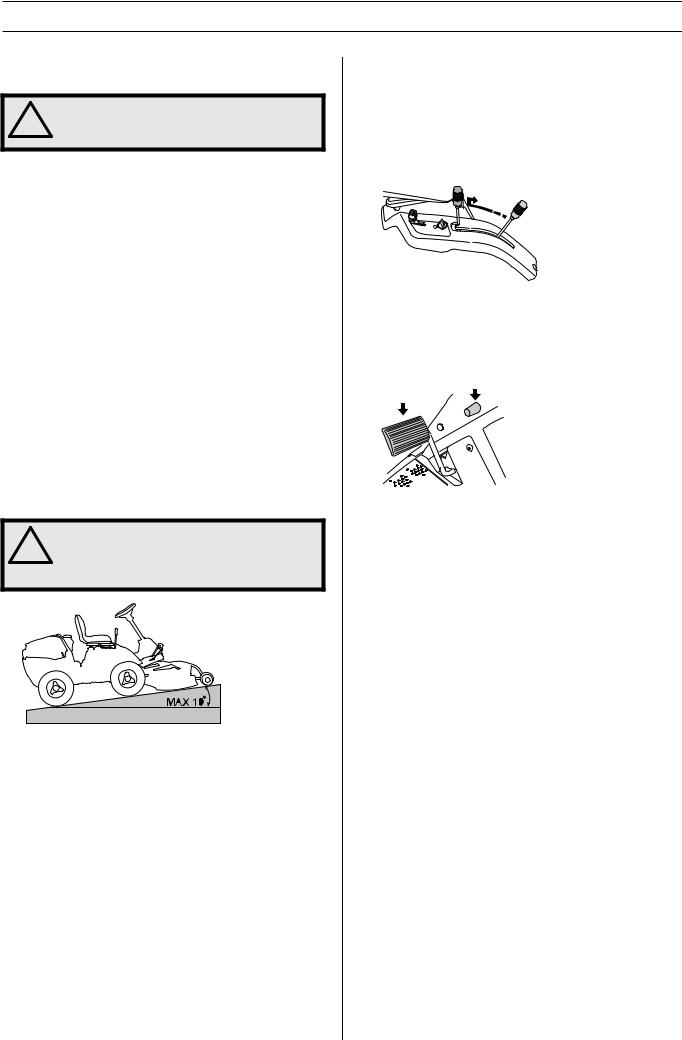
Driving
Cutting tips
WARNING! Clear the lawn of stones and
!other objects which can be thrown out by the blades.
•Localise and mark stones and other fixed objects to avoid collision.
•Start with a high cutting height and reduce down until the required mowing results are obtained.
•The mowing result will be best with the highest permitted engine speed, see technical data, (the blades rotate rapidly) and low speed (the Mower moves slowly). If the grass is not too high and thick, the driving speed can be increased without noticeably depreciating the mowing result.
•The best lawns are achieved if the grass is cut often. Mowing becomes more uniform and the grass cuttings become more evenly distributed over the surface. The total time consumption is not greater since it is possible to select a higher driving speed without inferior mowing results.
•Avoid mowing a wet lawn. The mowing results are inferior since the wheels sink down into the soft lawn.
•Hose down the cutting unit with water underneath each time it is used. The cutting unit should then be put in the service position.
WARNING! Do not use the machine on
!ground that slopes more than 10°. Mow slopes upwards and downwards, never across. Avoid sudden changes in direction.
Stop the engine
Preferably allow the engine to idle for a minute to obtain normal working temperature before stopping it if it has been working hard. Avoid idling the engine for long periods, as there is a risk of carbon build-up on the spark plugs.
1Lift up the cutting unit by pulling the lever backwards to its locked position.
2Pull back the throttle and let the motor idle for at least 30 sec.
3Turn the ignition key to the ”STOP”.
4When the Rider is at a standstill, press down the parking brake and push in the locking button.
English – 17

Maintenance
Maintenance schedule
The following is a list of the maintenance which should be conducted on the machine. For those points not described in this manual, visit an authorised service workshop.
Maintenance |
Daily maintenance |
At least once |
|
Maintenance |
||||
before starting |
a year |
interval in hours |
||||||
|
||||||||
|
|
|
|
|
|
|
||
|
|
|
25 |
|
50 |
100 |
200 |
|
|
|
|
|
|
|
|
|
|
Cleaning |
X |
|
|
|
|
|
|
|
|
|
|
|
|
|
|
|
|
Check the engine’s oil level |
X |
|
|
|
|
|
|
|
|
|
|
|
|
|
|
|
|
Check the engine’s cooling air intake |
X |
|
|
|
|
|
|
|
|
|
|
|
|
|
|
|
|
Check the steering wires |
X |
|
|
|
|
|
|
|
|
|
|
|
|
|
|
|
|
Check the battery |
X |
|
|
|
|
|
|
|
|
|
|
|
|
|
|
|
|
Check the safety system |
X |
|
|
|
|
|
|
|
|
|
|
|
|
|
|
|
|
Check nuts and screws |
O |
|
|
|
|
|
|
|
|
|
|
|
|
|
|
|
|
Check for fuel and oil leakage. |
O |
|
|
|
|
|
|
|
|
|
|
|
|
|
|
|
|
Clean around the muffler |
O |
|
|
|
|
|
|
|
|
|
|
|
|
|
|
|
|
Change engine oil 1) |
|
|
X |
|
X |
|
|
|
Replace the air filter’s prefilter2) |
|
|
X |
|
|
|
|
|
|
|
|
|
|
|
|
|
|
Check the cutting deck |
|
|
X |
|
|
|
|
|
|
|
|
|
|
|
|
|
|
Check the tire pressures. |
|
|
X |
|
|
|
|
|
|
|
|
|
|
|
|
|
|
Lubricate joints and shafts 3) |
|
|
X |
|
|
|
|
|
Check the V-belts |
|
|
O |
|
|
|
|
|
|
|
|
|
|
|
|
|
|
Checking and adjusting of throttle wire |
|
|
|
|
X |
|
|
|
|
|
|
|
|
|
|
|
|
Replace the air filter’s pre-filter and paper filter 2) |
|
|
|
|
|
X |
|
|
Replace the fuel filter |
|
|
|
|
|
X |
|
|
|
|
|
|
|
|
|
|
|
Replace the spark plug. |
|
|
|
|
|
X |
|
|
|
|
|
|
|
|
|
|
|
Check the fuel hose. Replace if necessary .4) |
|
O |
|
|
|
|
|
|
1)First change after 8 hours. When operating with a heavy load or at high ambient temperatures, replace every 25 hours. 2)Clean and replace the filter more often in dusty conditions. 3)If the machine is used daily it should be lubricated twice a week. 4)Conducted by authorised service workshop.
X = Described in this operator's manual
O = Not described in this operator's manual
WARNING! No service procedures must be
!conducted on the engine or cutting unit unless:
The engine is switched off. The ignition key is removed.
The ignition cable has been removed from the spark plug.
The parking brake is applied. The cutting unit is disengaged.
18 – English

Maintenance
Cleaning
Clean the machine directly after use. It is much easier to wash off grass cuttings before they dry.
Oily dirt can be removed using a cold degreasing agent. Spray on a thin layer.
Rinse at normal water pressure.
Do not direct the jet towards electrical components or bearings.
Do not rinse hot surfaces such as the engine and exhaust system.
Hose down the cutting unit with water underneath each time it is used.
It is recommended that you start the engine and run the mower for a short period after cleaning, so that any remaining water is blown off.
Lubricate the machine if necessary after cleaning. Carry out extra lubrication when the bearings have been exposed to a degreaser or a water jet.
IMPORTANT! Avoid using a high pressure washer or a steam cleaner.
There is a major risk of water penetrating into bearings and electrical connections. Corrosion attack can result, which will lead to running problems. Cleaning additives generally aggravate the damage.
Removing of the machine hoods
Engine cover
The engine becomes accessible for service when the engine cover is opened.
Loosen the snap locks (one on each side) and fold the cover backwards.
To remove the rear cover completely, pull it back sharply when in raised position.
Front cover
Release the clip on the right side of the mower deck and lift the cover off the mower deck.
Right-hand fender
Remove the screws and the back pedal knob, and lift off the cover.
Left-hand fender
Loosen the screws holding the wing cover and lift off the cover.
English – 19
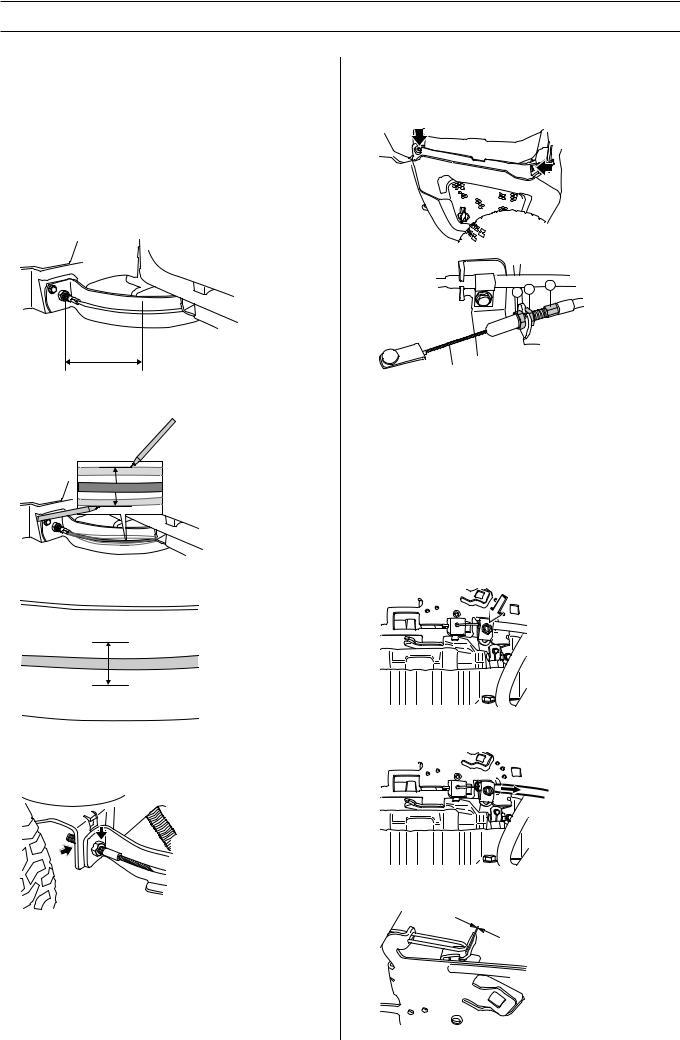
Maintenance
Checking and adjusting the steering wires
The steering is controlled by means of wires. These can in time become slack, which implies that the adjustment of the steering becomes altered.
Check and adjust the steering as follows:
1Position the wheels straight ahead.
2Tension can be checked approximately 150 mm along the wire from the adjustment screw.
150 mm
3Push the wire by hand up and down on the steering collar. Make a mark at the top and bottom positions.
4Measure the distance between the marks. The distance should be 15 ± 5 mm
15+-5 mm
5If necessary, the wires can be adjusted by tightening the adjuster nuts on each side of the steering collar. Do not over tighten the cables; they should only be drawn in towards the steering collar.
Hold the cable, for example using an adjustable wrench, so that it does not twist.
If you only tension one side the steering wheel’s centre position may change.
Check the wire tension on completion of the adjustment as per item 2.
Adjusting the P-brake
1Open the engine cover backwards.
2Remove the protective cover.
2
1 1
3Loosen the locking nuts (1).
4Tension the cable using the adjuster screw (2) until the play in the cable is taken up.
5Tighten the locking nuts (1) after adjustment.
Adjusting the throttle wire
The throttle cable may need to be adjusted, if the engine does not respond as it should when accelerating, if it produces black smoke or maximum revs are not reached.
1Release the clamping screw that secures the wire casing and set the choke control to maximum choke.
2Pull the choke wire casing to the far right and tighten the clamping screw.
3Pull back the throttle to the full throttle position and check that the choke is no longer actuated.
20 – English
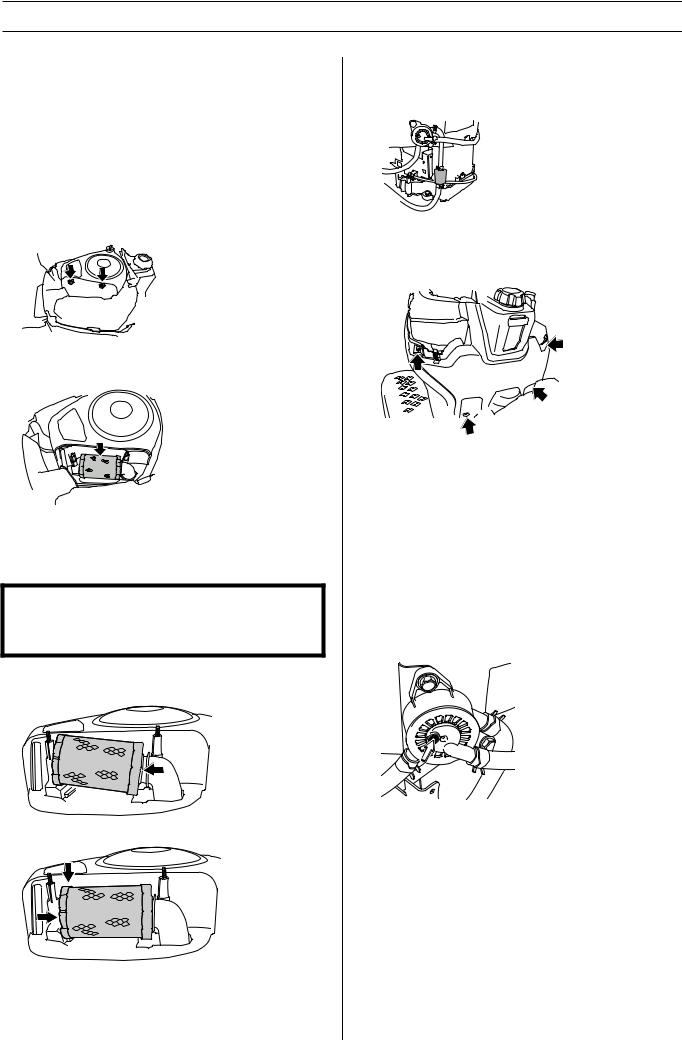
Maintenance
Replacing the air filter
If the engine seems to lack power or does not run smoothly this may be because the air filter is clogged. It is therefore important to replace the air filter at regular intervals (see Maintenance/Maintenance Schedule for the correct service interval).
Replace the air filter as follows:
1Open the engine cover.
2Loosen the knobs holding the filter cover in place and remove it.
3Remove the air filter cover.
4Lift out the air filter cartridge from the fan housing.
5Remove the foam rubber prefilter which is placed around the filter cartridge and clean using a mild detergent.
Dry the pre-filter properly.
IMPORTANT INFORMATION
Do not use compressed air to clean the paper filter.
Do not oil the paper filter. They must be fitted dry.
6Refit the prefilter on the filter cartridge.
7Slide the filter onto the air hose.
8 Push the filter cartridge in place.
9 Refit the air filter cover.
Replacement of fuel filter
Replace the fuel filter every 100 running hours (once per season) or more frequently if it is clogged.
Replace the filter as follows:
1Open the engine cover.
2Remove the protective cover by unscrewing the screws.
3Move the hose clips away from the filter. Use a pair of flat pliers.
4Pull off the filter from the hose ends.
5Press the new filter into the ends of the hoses. If necessary apply liquid detergent to the ends of the filter to facilitate connection.
6Push the hose clips back on the filter and tighten.
Checking the fuel pump’s air filter
Check regularly that the fuel pump’s air filter is free from dirt.
The filter can when necessary be cleaned with a brush.
English – 21
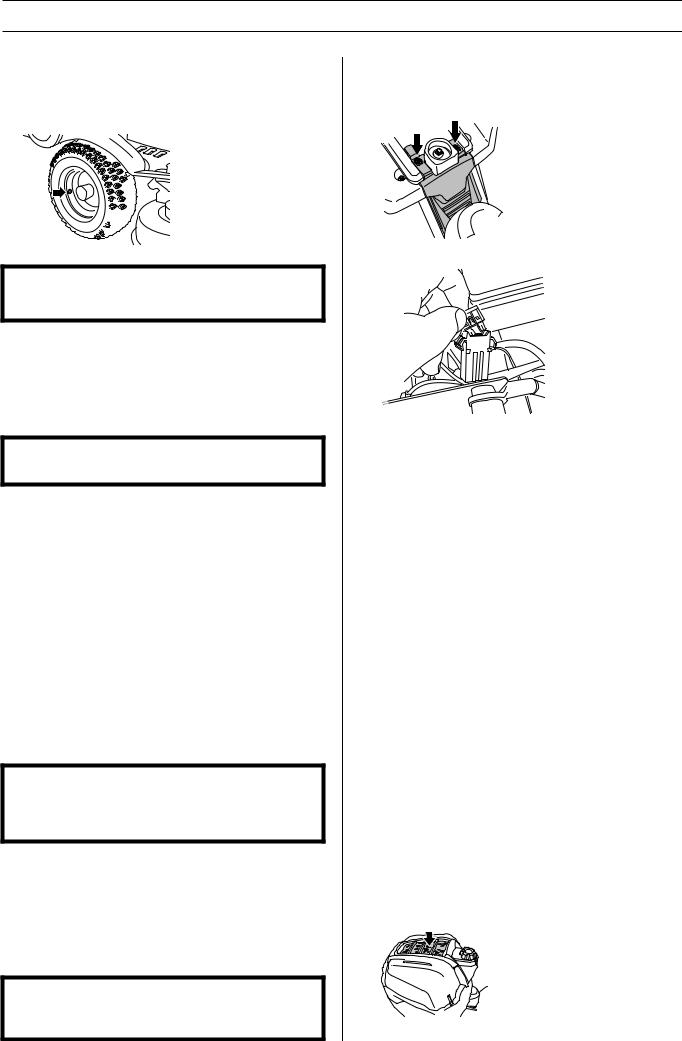
Maintenance
Checking the Tire Pressure
The tire pressure should be 60 kPa / 0.6 bar / 8,7 PSI on all wheels. In order to improve traction, the pressure in the rear tyres can be reduced to 40 kPa / 0.4 bar / 6 PSI.
IMPORTANT INFORMATION Different tire pressures on the front tires will result in the blades cutting the grass at different heights.
Ignition system
The engine is equipped with an electronic ignition system. Only the spark plug requires maintenance.
For recommended spark plug, see Technical data.
IMPORTANT INFORMATION
Fitting the wrong spark plug type can damage the engine.
Replacing the spark plug
1Remove the ignition cable boot and clean around the spark plug.
2Remove the spark plug with a 5/8” (16 mm) spark plug socket wrench.
3Check the spark plug. Replace the spark plug if the electrodes are burned or if the insulation is cracked or damaged. Clean the spark plug with a steel brush if it is to be reused.
4Measure the electrode gap with a gapping tool. The gap should be 0.75 mm/0.030”. Adjust as necessary by bending the side electrode.
5Reinsert the spark plug, turning by hand to avoid damaging the threads.
IMPORTANT INFORMATION
Inadequately tightened spark plugs can cause overheating and damage the engine. Tightening the spark plug too much can damage the threads in the cylinder head.
6Tighten the spark plug, once it touches the seating, with the spark plug socket wrench. Tighten the spark plug so that the washer is compressed. A used spark plug should be turned 1/8 of a turn from the seated position. A new spark plug should be turned a 1/4 turn from the seated position.
7Replace the ignition cable shoe.
IMPORTANT INFORMATION
Do not turn over the engine if the spark plug or ignition cable has been removed.
Fuses
The main fuse is placed in a detachable holder behind the battery under the protective cover.
Type: Flat pin, 15 A.
Do not use any other type of fuse when replacing.
A blown fuse is indicated by a burnt connector. Pull the fuse from the holder when replacing.
The fuse is there to protect the electrical system. If it blows again shortly after replacement, it is due to a short circuit, which must be fixed before the machine can be put into operation again.
Check the safety system
The machine is equipped with a safety system that prevents starting or driving under the following conditions.
The engine can only be started when:
•The cutting deck is raised and the parking brake is applied.
The engine should stop when:
•The cutting deck is lowered and the driver rises from the seat.
•The cutting deck is in its raised position, the parking brake is not applied and the driver rises from the seat.
Check daily to ensure that the safety system works by attempting to start the engine when one of the conditions above is not met. Change the conditions and try again.
Checking the engine’s cooling air intake
Clean the air intake grille in the engine cover behind the driver’s seat.
22 – English

Maintenance
Open the engine cover.
Check that the cooling intake is free from leaves, grass and dirt.
Check the air duct, located on the inside of the engine cover, ensure it is clean and does not rub against the cooling air intake.
A blocked cooling intake will interfere with the cooling of the engine, which can damage the engine.
WARNING! The cooling air intake rotates
!when the engine is running. Do not allow hands, clothing, jewelry or any other items to come in contact with the engine fan while the engine is running. Mind your fingers.
Service position for the cutting unit
The cutting deck can be removed in order to facilitate cleaning and servicing.
To remove the cutting deck proceed as follows:
1Position the machine on flat ground.
2Apply and lock the parking brake.
3Check that the lever for setting the cutting height is in the S position.
4 Put the lifting lever in the mowing position.
5Release the clip on the right side of the mower deck and lift the cover off the mower deck.
6Loosen the spring on the drive belt’s belt idler by loosening the handle.
7Lift of the drive belt.
8Grip the top tubular construction of the unit and pull out the unit until it stops.
9 Remove the pin in the equipment frame.
10 Loosen the stay from the cutting deck.
11Pull out the cutting unit.
12Lift off the deck and lean it against the machine or a wall.
English – 23
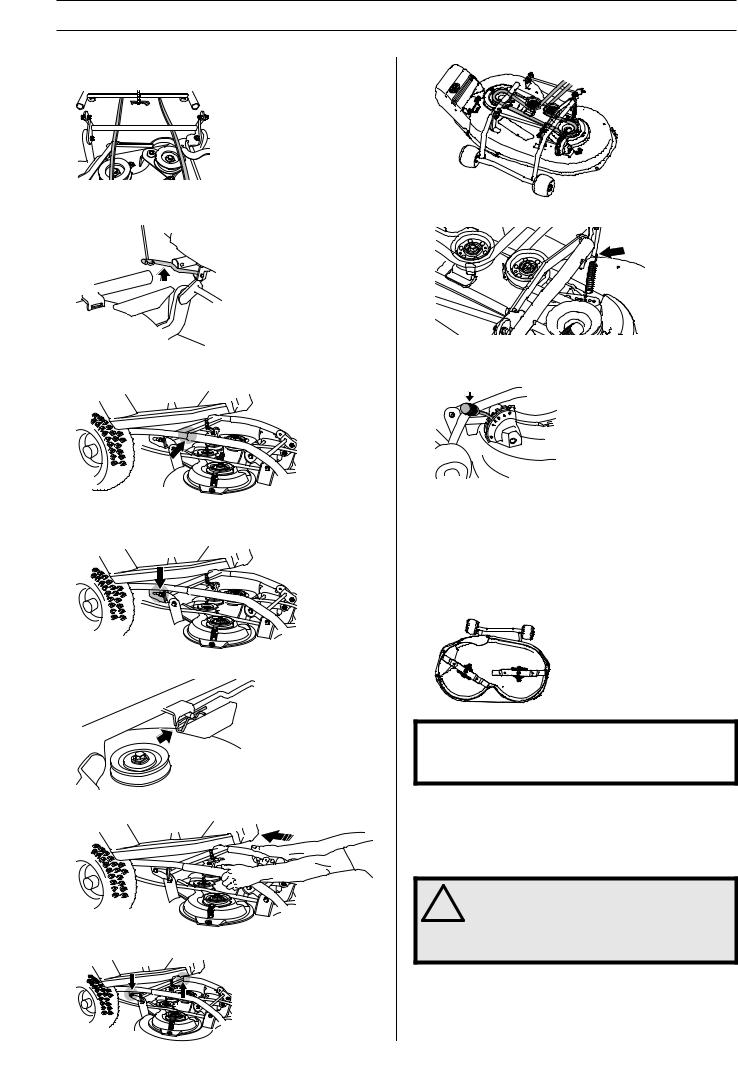
Maintenance
Fitting the cutting head
1 Place the belt under the stay of the cutting deck.
2Make sure the lifting lever comes above the cutting deck grip.
3Fit the cutting deck's pipe together with the deck frame's pipe.
4Push the cutting deck in and make sure the guide bolts fit into the grooves on the deck frame, one on each side.
5 Fit the cutting deck lock.
6 Grab the pipes and push the deck in.
7 Push the deck until you feel the pipes touch bottom.
8 Fit the belt according to the picture.
9 Tension the belt with the belt adjuster.
10Fit the front cover.
11Set the cutting height control to one of the positions 1-5
Checking the blades
To achieve the best mowing results it is important that the blades are undamaged and well-sharpened.
Check that the blades’ attachment screws are tight.
•Put the unit in the service position, see Service position for the cutting unit.
IMPORTANT INFORMATION
Replacing or sharpening the blades should be conducted by an authorised service workshop.
The blades should be balanced after sharpening.
Damaged blades should be replaced when hitting obstacles that result in a breakdown. Let the service centre assess whether the blade can be sharpened or must be replaced.
! |
WARNING! Do not use blades that are |
cracked, chipped, or otherwise show signs |
|
of damage or severe wear. Replace the |
|
|
blades. The risk increases if the blades are |
|
poorly balanced. |
24 – English
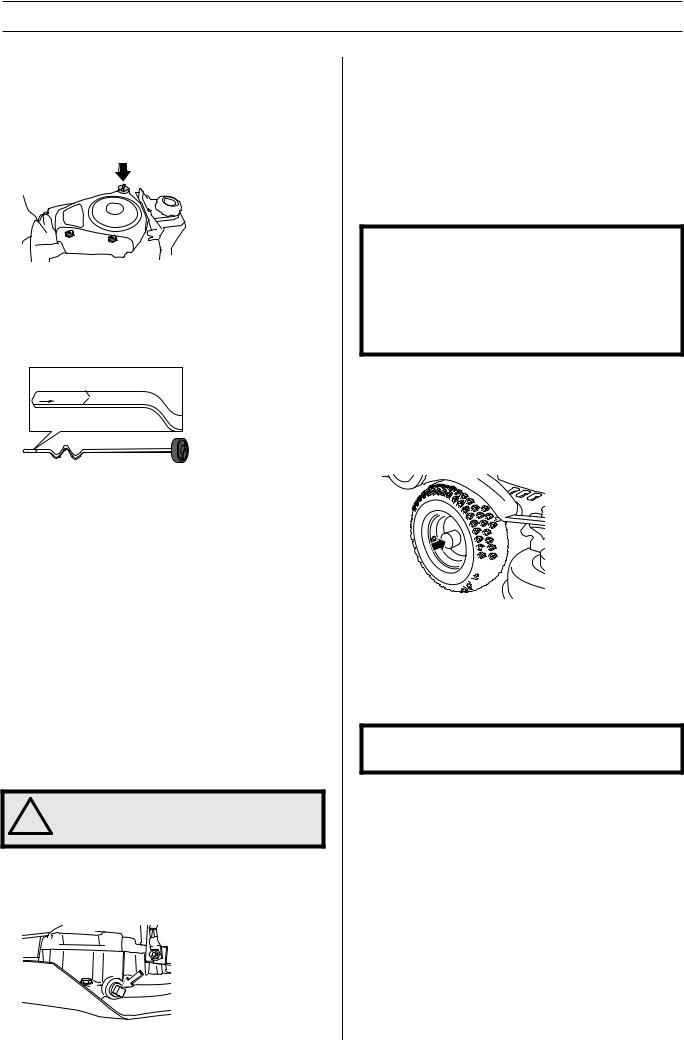
Lubrication
Checking the engine’s oil level.
Check the oil level in the engine when the Rider is on level ground. Do not check the oil with the engine running.
Open the engine cover.
Loosen the dipstick, pull it up and wipe it off.
Reinstall the dipstick and screw it all the way down
Pull the dipstick out again and read the oil level.
The oil level should be between the markings on the dipstick. If the level is approaching the ADD mark, top up the oil to the FULL mark on the dipstick.
ADD 




 FULL
FULL
ADD 


 FULL
FULL
The oil is topped off through the hole the dipstick sits in.
Fill the oil slowly. Tighten the dipstick correctly before starting the engine. Start and run the engine at idling speed for approx. 30 seconds. Turn off the motor. Wait 30 seconds and check the oil level. If necessary fill so that the oil comes up to the FULL mark on the dipstick.
Use synthetic engine oil class SJ-CF 5W/30 or 10W/30 for all temperature ranges. Mineral oil SAE30, class SF–CC can be used at temperatures > +5 °C (40 °F)
Do not mix different types of oil.
Replacing the engine oil
The engine oil should be changed the first time after 8 hours running time. It should then be changed after every 50 hours of running time.
When operating with a heavy load or at high ambient temperatures, replace every 25 hours.
WARNING! Engine oil can be very hot if it is
!drained directly after stopping the engine. Allow the engine to cool somewhat first.
1Place a container underneath the engine’s left oil drain plug.
2Remove the dipstick. Remove the drain plug from the engine’s left side.
3 Let the oil run out into the container.
4Fit the drain plug and tighten it.
5Fill with oil up to the ”FULL” mark on the dipstick The oil is topped off through the hole the dipstick sits in. See Checking the engine’s oil level for filling instructions.
The engine holds 1.5 litres (1.6 USqt) when the oil filter is not replaced and 1.7 litres (1.8 USqt) of oil when the oil filter is replaced.
6Run the engine warm, then check that there is no leakage from the oil plug.
IMPORTANT INFORMATION
Used engine oil, antifreeze etc. is a health hazard and must not be disposed of on the ground or in nature; it should always be disposed of at a workshop or appropriate disposal location.
Avoid skin contact; wash with soap and water in case of spills.
Lubricating the front wheel bearings
Jack up the front wheels and support the front end so the front wheels are off the ground.
1Remove the plastic cover that covers the centre of the wheel.
2Remove the circlip and washer on the front wheel axle.
3Lift off the wheel.
4Lubricate the stub axle with molybdenum disulphide grease*.
5Assemble the parts in the reverse order.
IMPORTANT INFORMATION
Check that the circlip enters the groove correctly.
*Grease from well-known brand names (petrochemical companies, etc.) usually maintains a good quality. The most important property is that the grease provides good protection against corrosion.
General lubrication
All joints and bearings are lubricated using molybdenum disulphide grease during manufacture. Continue to lubricate using the same type of grease *. Lubricate the steering and control wires using engine oil.
Carry out this lubrication regularly.
*Grease from well-known brand names (petrochemical companies, etc.) usually maintains a good quality. The most important property is that the grease provides good protection against corrosion.
English – 25

|
Troubleshooting schedule |
|
|
|
|
|
|
Problem |
|
Cause |
|
|
|
|
|
|
|
|
|
Engine does not start |
|
There is no fuel in the fuel tank |
|
|
|
|
|
|
|
Spark plug defective |
|
|
|
|
|
|
|
Faulty spark plug connections or interchanged cables |
|
|
|
|
|
|
|
Dirt in the carburetor or fuel line |
|
|
|
|
|
|
|
Starter motor does not turn over the engine |
|
|
|
|
|
|
|
|
|
Starter motor does not turn over the |
Battery discharged |
|
|
engine |
|
|
|
|
|
|
|
|
|
|
|
|
|
Bad contact between the cable and battery |
|
|
|
|
|
|
|
Lift lever for cutting unit in wrong position |
|
|
|
|
|
|
|
Main fuse blown. |
|
|
|
|
|
|
|
Ignition lock faulty |
|
|
|
|
|
|
|
Brake not activated. |
|
|
|
|
|
|
|
Faulty starter motor |
|
|
|
|
|
|
|
|
|
Engine does not run smoothly |
|
Faulty spark plug. |
|
|
|
|
|
|
|
Carburettor incorrectly set |
|
|
|
|
|
|
|
Air filter clogged |
|
|
|
|
|
|
|
Fuel tank vent blocked |
|
|
|
|
|
|
|
Ignition key defective |
|
|
|
|
|
|
|
Dirt in the carburetor or fuel line |
|
|
|
|
|
|
|
Choking or incorrectly adjusted throttle cable |
|
|
|
|
|
|
|
|
|
Engine seems to have no power |
|
Air filter clogged |
|
|
|
|
|
|
|
Spark plug defective |
|
|
|
|
|
|
|
Dirt in the carburetor or fuel line |
|
|
|
|
|
|
|
Carburettor incorrectly set |
|
|
|
|
|
|
|
Choking or incorrectly adjusted throttle cable |
|
|
|
|
|
|
|
|
|
Engine overheats |
|
Engine overloaded |
|
|
|
|
|
|
|
Spark plug defective |
|
|
|
|
|
|
|
Air intake or cooling flanges blocked |
|
|
|
|
|
|
|
Fan damaged |
|
|
|
|
|
|
|
Too little or no oil in engine |
|
|
|
|
|
|
|
Ignition defective |
|
|
|
|
|
|
|
|
|
Battery does not charge |
|
One or more battery cells faulty |
|
|
|
|
|
|
|
Poor contact on the battery terminal cable connectors |
|
|
|
|
|
|
|
|
|
Machine vibrates |
|
Blades are loose |
|
|
|
|
|
|
|
Engine is loose |
|
|
|
|
|
|
|
One or more blades unbalanced, caused by damage or poor balancing after |
|
|
|
sharpening |
|
|
|
|
|
|
|
|
|
Uneven mowing |
|
Blades blunt |
|
|
|
|
|
|
|
Long or wet grass |
|
|
|
|
|
|
|
Cutting unit skew |
|
|
|
|
|
|
|
Grass blockage under hood |
|
|
|
|
|
|
|
Different tyre pressures on right and left sides |
|
|
|
|
|
|
|
Over-speeding |
|
|
|
|
|
|
|
Engine speed too low |
|
|
|
|
|
|
|
Drive belt slipping |
|
|
|
|
|
26 – English
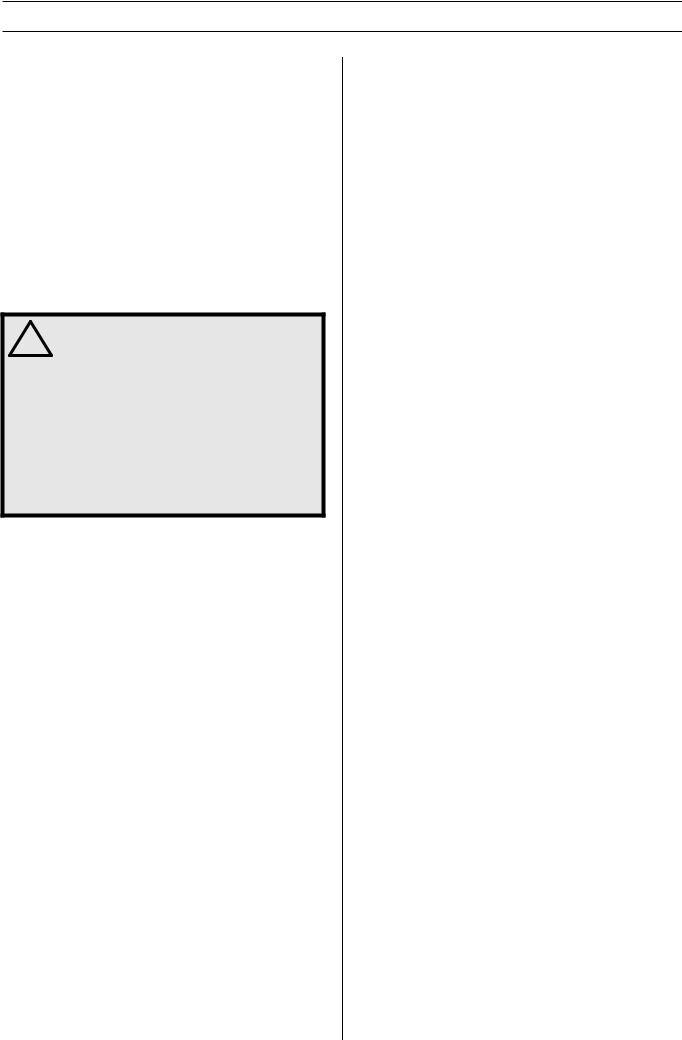
Storage
Winter storage
At the end of the season, or if the machine is going to stand idle for more than 30 days, it should immediately be made ready for storage. Fuel which is left to stand for long periods (30 days or more) can leave tacky deposits which can block the carburettor and interfere with the engine.
Fuel stabiliser is an acceptable alternative to avoid tacky deposits during storage. However, one should avoid changing from standard to alkylate petrol since sensitive rubber parts can harden. Add stabiliser to the fuel in the tank or the storage container. Always use the mixing ratios indicated by the manufacturer. Run the engine for at least 10 minutes after adding the stabiliser so that it will reach the carburettor. Do not empty the fuel tank and carburettor if stabiliser has been added.
WARNING! Never store a machine with fuel
!in the tank indoors or in poorly ventilated spaces where fuel vapour can come in contact with open flames, sparks, or a pilot light such as in a boiler, hot water tank, clothes drier, etc. Exercise caution when handling fuel. It is highly inflammable, and careless use can cause serious injury and damage to property. Drain off the fuel in an approved container outdoors and well clear of naked flames. Never use petrol for cleaning purposes. Use degreasing agents and hot water instead.
To prepare the machine for storage follow these instructions:
1Carefully clean the machine, especially under the cutting unit. Touch-up paint damage to avoid rust.
2Inspect the machine for worn or damaged parts and tighten loose screws and nuts.
3Change the engine oil, and take care of the waste oil.
4Empty the fuel tank. Start the engine and run it until the carburettor is emptied of fuel.
5Remove the plugs and pour about a tablespoon of engine oil into each cylinder. Turn the ignition key to the ”start” position for a few seconds to distribute the oil and screw the plugs back on.
6Grease all grease nipples, joints and axles.
7Remove the battery. Clean it, charge it, and store it in a cool place.
8Store the machine in a clean and dry place and cover it over for extra protection.
Service
Winter is the most suitable time to perform a service or overhaul of the machine in order to ensure high function safety during high season.
When ordering spare parts state your machine’s purchase year, model, type, and serial number.
Always use genuine parts.
An annual check-up by an authorised servicing dealer is a good way to ensure that your ride-on mower performs at its best the following season.
English – 27
